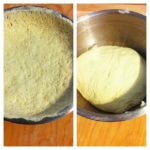Why is My Homemade Pizza Soggy?

Why is My Homemade Pizza Soggy?
Pizza crafted from the ground up with just a hint of tomato sauce embodies one of the quintessential flavors of pizza. However, the challenge arises in creating a homemade pizza that is both delicious and not overwhelmingly messy. Preparing pizza at home is relatively simple, and I possess recipes that yield reliably consistent results. The issue emerges, though, if you fail to maintain a uniform shape for your pizza dough. This can lead to air pockets under the sauce, resulting in a crust that turns out soggy.
Pizza dough should be stored in an air tight container so that air does not get trapped in it. It is important that the dough is not exposed to high temperatures which can cause it to rise. This will result in an unappealing crust. In addition, using too much oil on homemade pizza will also result in the soggy crust.
If you have made a mistake and baked an undercooked crust, then the next question that you should ask is “Why is my homemade pizza soggy?” My biggest concern is that people do not read the recipe properly. When I make a recipe, I always start by putting the ingredients in their liquid state. This would mean mixing all ingredients together in a pan and heating them up until they are ready. If you mix them in the bowl or in the pan, then they will not be mixed as well as they should be and will end up hardening because they will not seal properly. Your homemade pizza may still be soggy on the bottom but it will look fine on the outside.
The next step that you need to take when making homemade pizza crust is to make sure that you use a wooden spoon to scrape the bottom of the pizza. This is important because the wood will help absorb some of the grease that will be stuck to your pizza crust. However, once you have the bottom portion of the pizza crust clean, then you can move on to washing and drying the other parts of the pizza. It is important that you do not skip this part of the process because if you do, then you will end up with soggy pizza crust that will not taste good.
Now that you have your pizza crust clean, you need to remove it from the heat source that it was baking in. For that, you can either use a normal oven or you can use the microwave. In order to dry out your crust properly, you can either bake it in the oven for about an hour and then turn it off or you can place it on a baking sheet in the oven and place it in the microwave for a minute at most. Once both of these processes are complete, then you can put your homemade pizza crust in a plastic container and either store it in the freezer or you can use it immediately.
Now that you have your pizza soggy, you need to remove the baking soda that has accumulated to the bottom of your pie. For that, you can either use a wire towel or you can use paper towels. Once you have removed the baking soda, then you can either transfer it to a zip lock bag or you can place it into a small bowl in the freezer. Once the baking soda is frozen, then you can easily put it back into your homemade pizza crust.
Now that you have completed those steps, you need to remove the pie from the oven. For that, you can either place it under the broiler for a few minutes or you can use a thermometer to measure the internal temperature of your baked pizza crust. Once you have done that, then you need to let your pizza cool down. To do that, you can place it in your refrigerator or you can place it on the counter and leave it until it is completely cooled down. However, you should remember that baking pizza crusts at a high temperature is not very healthy for you.
If you are asking yourself, “Why is my homemade pizza soggy?” then you should know that the pizza dough that you are using has a lot of moisture on it. If you allow it to sit for an extended period of time without baking it, then the pizza dough is likely to become soggy. As a result, you will not only lose the elasticity of your homemade pizza crust, but you will also end up with a soggy, unappealing crust. Therefore, you should always make your homemade pizza at the proper temperature and you should always bake it for the appropriate amount of time.


























